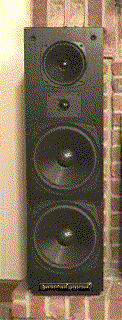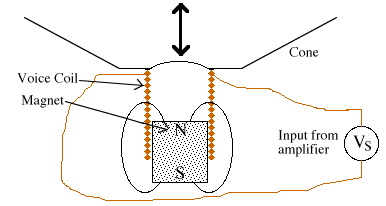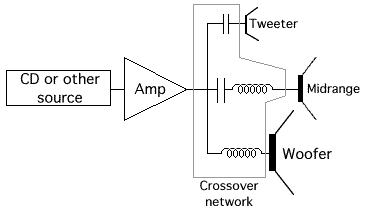
 |
 |
 |
|---|
 |

If you like to listen to music, physics is good for that too. In recent weeks, we have studied magnetic fields and forces, and we are about to start studying alternating current circuits. All of these topics are needed to understand the operation of a loudspeaker.
We have recently learned that magnetic fields are produced by current flowing in wires, and that wires carrying current feel magnetic forces. I have also written a bit about magnetic materials. However, the connection may still not be quite clear. This page will attempt to clear up the difficulty, and turn to an extremely popular application: the loudspeaker. In a loudspeaker, current flowing in wires puts a force on a piece of magnetic material. That magnetic material moves in response. In turn, the magnet pushes a paper or plastic cone, and the cone pushes the air. The result is sound, perhaps music.


If these model atoms are placed in a uniform external magnetic field they will feel a torque but they will feel no net force The figure to the left shows this situation. In this view, the motion of the electron is into the page at the lower left, out of the page in the upper right, and in the plane of the page, down and to the left as it passes "in front" of the atom. Using the right hand rule gives the forces shown (remember the electron has a negative charge!). There would also be forces out of the page in front and into the page
 |
| An atom (or any current loop) feels a torque that tends to align its magnetic moment with an external field. |
Here is an important point: Consider the electron to be a current loop. Thus, it generates a small magnetic field of its own. As drawn in the figure, the magnetic field at the center of the electron's orbit will be up and to the left (again, remember the electron is negative!). If the torque succeeds in rotating the electron's orbit, the magnetic field of the orbit will be aligned with the external magnetic field.
This explains how an unmagnetized piece of magnetic material becomes magnetically polarized (magnetized) by an external magnetic field. However, it does not explain the force that is felt. To understand this, we must recall that the field of a magnet is not uniform. It looks more like a dipole field.

 |
| An atom (or any current loop) feels a force that tends to pull it towards regions of higher field |
Now, finally, we can have a look at the guts of a loudspeaker. Here is a simplified cross section.

When current is passed through the coil it produces a magnetic field that is constant in magnitude inside and looks like that of a bar magnet outside (see the description of long, straight solenoids in your text).
If the current changes in time (like the signal from from your amplifier does) then the field will change in time with it. If the current is a sine wave, for instance, then the field will also be a sine wave. In this case, the magnet is attracted in or pushed out as the signal oscillates. In most speakers, it is the coil and cone that move while the magnet stays fixed. The force on the coil is equal and opposite to the force on the magnet.
Whose third law is this?
Music is not a simple sine wave, but it can be considered as a whole bunch of sine waves added to one another (The method of describing a complicated signal in terms of sines and cosines is called Fourier analysis, but we will not go into that here.) Simple loudspeakers (such as those in cheap car stereos, and the speakers that are built into most computers consist of a single speaker. However,even moderately priced home speakers have more than one "speaker" inside. The different speakers are optimized to perform best for different frequency ranges. Usually, the speaker that handles the high frequencies is called a "tweeter" and the one that handles lower frequencies is called a "woofer". In three-way systems there is also a "midrange", and more complex systems may include "'supertweeters" and "subwoofers."
 How does
each of these speakers know what part of the signal to
reproduce? Inside the loadspeaker, there is a set of circuitry
called a "crossover network" that divides the signal up into
frequency ranges, and sends the parts of the signal to each of
the speakers as needed. The figure to the right shows a
simplified version of a loudspeaker system with three speakers
and a simple crossover. The capacitor at the top of the
crossover filters out all but the highest frequencies (recall
that XC = 1/
How does
each of these speakers know what part of the signal to
reproduce? Inside the loadspeaker, there is a set of circuitry
called a "crossover network" that divides the signal up into
frequency ranges, and sends the parts of the signal to each of
the speakers as needed. The figure to the right shows a
simplified version of a loudspeaker system with three speakers
and a simple crossover. The capacitor at the top of the
crossover filters out all but the highest frequencies (recall
that XC = 1/ C).
Thus, the tweeter only responds to the high frequencies in the
music. The inductor (XL =
C).
Thus, the tweeter only responds to the high frequencies in the
music. The inductor (XL =  L) at the bottom does the same job for
the woofer, passing only the low frequencies. The
inductor-capacitor pair in the middle passes only the medium
frequencies to the midrange.
L) at the bottom does the same job for
the woofer, passing only the low frequencies. The
inductor-capacitor pair in the middle passes only the medium
frequencies to the midrange.
1.  2.
2.  >3.
>3. 